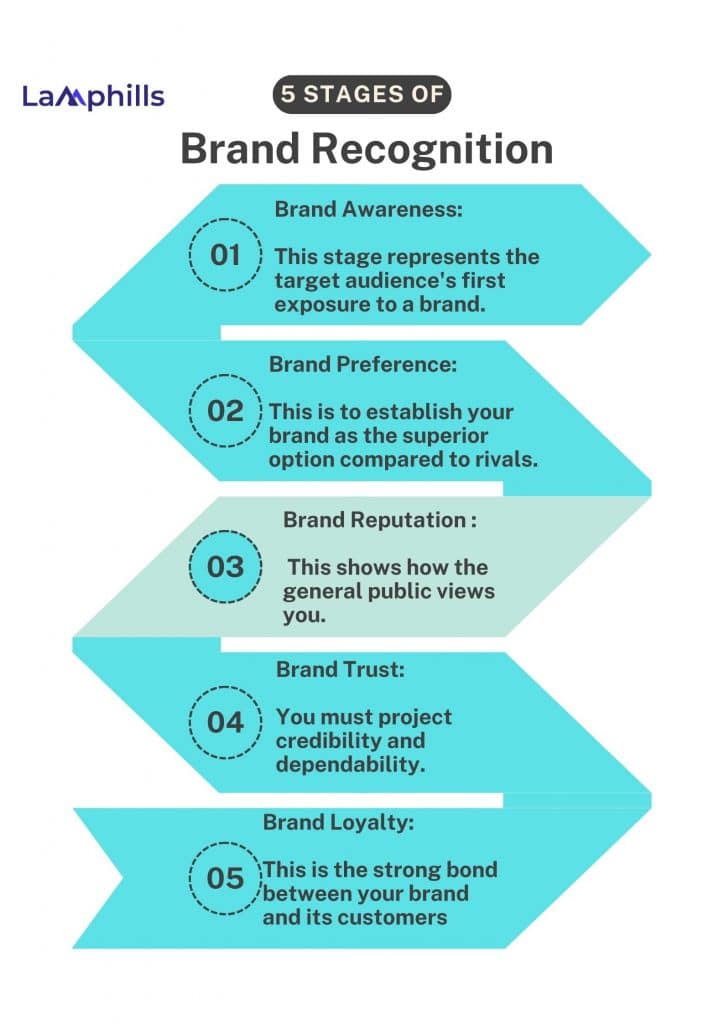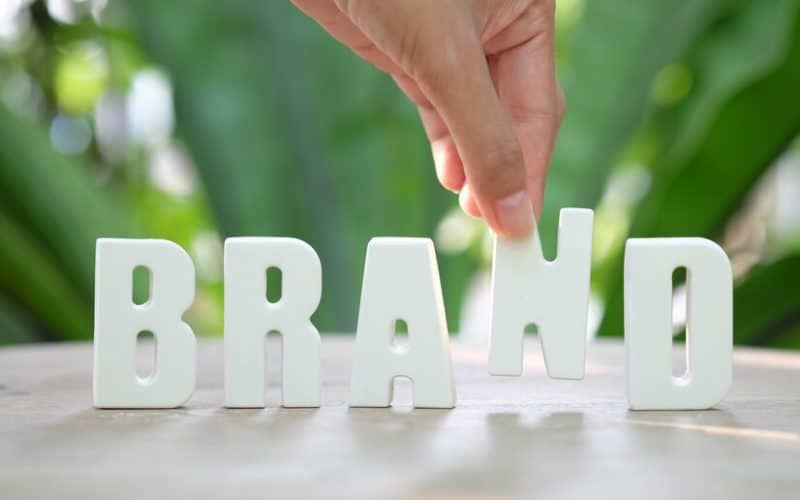Brand recognition helps businesses evaluate customers’ capacity to identify their business without necessarily knowing its name by using visual or aural cues, like a logo or jingle. Because your business’s brand shows what you offer your customers, gaining an understanding of how to establish and enhance brand recognition can boost sales, foster consumer loyalty, and set your company apart from rivals.
In this article, I will take you through what brand recognition is, its importance, and how to build a strong brand reputation.
Key Points
- The ability of customers to distinguish a distinguishing feature of one business from a rival is known as brand recognition.
- When customers can identify a company without hearing its name by just visual or auditory cues, it is considered to have successful brand recognition.
- Cues such as names, marks, logos, and jingles can help people recognize a brand.
- Your marketing team is responsible for creating brand cues.
- Advertising and marketing experts can create plans to increase a business’s target audience’s brand recognition.
What Is Brand Recognition?
Brand recognition is the degree to which customers can recognize a brand with accuracy, connect it to its goods, services, or reputation, and set it apart from other brands.
It is said that your customers must be able to recognize your brand as you constantly expose them to your visual or auditory signals through repeated exposure in a variety of settings.
How Brand Recognition Works?
To establish strong brand recognition, businesses frequently devote a significant amount of time and resources to marketing and commercials. These marketers conduct research to identify their target demographic and devise ways to draw in those customers to create a memorable brand. They work with other experts, like graphic designers, to create brand cues like images for advertisements.
Afterward, marketers perform market research studies to evaluate the effectiveness of their plans after putting their initiatives into action.
Read Also: How to Crafting a Compelling Brand Visual Identity: Expert Tips
How Does Brand Recognition Help Businesses?
Strong brand recognition can help your business in the following ways:
#1. It Improves Consumer Trust.
Customers are more likely to trust well-known brands than unknown ones. Customers are more inclined to make purchases and stick around if they are more familiar with your brand.
#2. It Boosts the User Experience:
Customers who are familiar with your brand may feel good about it. Customers may have a better user experience since they already trust your brand if they frequently hear favorable feedback from friends, family, and testimonials.
#3. Brand Recognition Increases Your Revenue:
Even if the quality of your products is the same as others on the market, customers are frequently prepared to pay extra for them because they believe they are buying a premium product. This, in turn, will grow your income and sales.
What are the 5 Stages of Brand Recognition?

To attain strong brand recognition, you must carry out a number of unique phases that steadily cement your brand in your consumers’ minds. Here, I will take you through the five stages of brand recognition.
#1. Brand Awareness
This stage represents the target audience’s first exposure to a brand. In order to promote your awareness, you must work to make yourself more visible using a variety of marketing and advertising platforms so that people are aware of the brand’s presence and connect it to the particular goods or services it provides.
For example, you can cite the way people connect Adidas products to football or jerseys.
Read Also: Brand Awareness Ideas: Most Effective Ideas in 2024 (Practical Tips)
#2. Brand Preference
The next step after gaining customer awareness is for you to establish your brand as the superior option compared to rivals. During this phase, you must demonstrate how your goods or services can help your customers, and provide outstanding customer service.
Read Also: How To Measure Brand Awareness: KPIs To Look Out For
#3. Brand Reputation
A brand’s reputation shows how the general public and consumers generally view it in relation to product quality, customer service, brand values, and ethical behavior. Therefore, you must concentrate on fulfilling your brand promises, respond to customer feedback, and be transparent in your business practices.
Read Also: Reputation Recovery: How Experts Turn Negative PR into a Growth Opportunity
#4. Brand Trust
To gain consumer trust, a brand must project credibility and dependability. To achieve this trust, your brand must emphasize responsible behavior, positive experiences, and open communication—all of which support the development of enduring bonds with consumers.
#5. Brand Loyalty
This is the pinnacle of brand recognition, and it happens when there is a strong emotional bond between your brand and its customers. To gain customer loyalty, you must meet or exceed customer expectations, provide distinctive value, and cultivate a sense of community.
Furthermore, when customers develop brand loyalty, they stick with the brand, choose it, and promote it to others. This provides free advertising for your business and turns loyal customers into repeat buyers over an extended time.
Read Also: 7 Simple Practical Steps to Build Brand Loyalty
How to Create a Brand Awareness Strategy
Here, I will introduce you to brand recognition strategies that will establish your business as a leader in your market.
#1. Establish Your Brand’s Identity.
Brand identity is the visual and conceptual representation of a brand. A strong brand identity makes it easier for potential customers to relate to, identify, and distinguish your company from competitors. Establishing your brand’s identity, which includes distinct elements like logos, color schemes, and typography, as well as its unique voice, messaging, values, objectives, target market, and unique selling point, is the first stage.
#2. Create Consistent Brand Communications
Brand consistency refers to how your company’s image and message are consistent throughout all of your marketing channels, appealing to both current and prospective clients. You must develop a compelling brand message that communicates your company’s benefits, value proposition, and unique selling points to your target market.
For instance, people can quickly identify KFC’s family-friendly fast-food outlets and affordable meals by its signature smiley face and red and white color scheme. Maintaining consistency in your brand aids in customer retention.
Read Also: How Bad Communication Costs Your Business & How to Fix It in 7 Steps
#3. Create A Powerful Visual Identity
Visual identity refers to the components—such as the logo, color scheme, web design, illustration style, animation style, typography, icons, and photography that are utilized to represent a business, organization, or product.
Visual identity contributes to the development of an appealing and recognizable visual image of a brand for customers. Establishing a strong visual identity for all your marketing materials and merchandise can set your brand apart from its rivals and foster consumer trust. Additionally, these visual components speak to your target audience and convey the essence of your brand.
For example, Coca-Cola is famous for its iconic red-and-white logo, which has stood the test of time. Coca-Cola maintains brand loyalty among its customers through consistency, distinctive brand colors, and logo design.
#4. Establish An Online Presence
Create a professional online presence by designing a website and participating actively on social media sites that are relevant to your business. Make use of SEO web design to boost traffic and visibility.
For instance, GoPro, the most versatile camera in the world, uses social media platforms to promote products, engage with customers, and create valuable content.
GoPro has a strong online presence, but they use each one differently. They don’t just share the same stuff on all of their social media platforms. They have carefully determined the optimal uses for each platform and developed a plan to make the most of them all.
In addition, GoPro promotes participation through online competitions called the GoPro Awards, where users can upload images or films they’ve captured with GoPro cameras.
Read Also: Monitoring Online Content: How To Do This In 5 Steps
#5. Stay Consistent On All Platforms
Make sure that your website, packaging, marketing materials, social media profiles, and advertising efforts are all consistent with one another.
Your brand’s visual identity and messaging should be consistent across all channels, even when branding, marketing, and language may change based on the platform. Maintaining a steady presence will aid in improving brand recognition.
For example, Google ensures that its brand is appropriately represented on various social media platforms. One of the most important lessons to learn from Google’s constant social branding is that its current design and graphics are consistent across all of its platforms. They encourage other brands to use standardized fonts, colors, icon styles, and logos
#6. Prioritize Content Marketing
Create a content marketing plan that speaks to your target audience and is consistent with your brand’s values. Provide entertaining, targeted, and pertinent material for a variety of platforms to bolster your brand’s authority.
By doing this, you may establish your brand as a thought leader and subject matter expert in your industry, which will win over customers’ trust.
For example, IBM, a well-known IT company, is great at content marketing. Its resource page offers a wealth of analyst papers, infographics, case studies, and videos. Its blog offers technical depth on various topics, like the research for the cure for Ebola.
Read Also: What Is Creative Content? All You Need 2024
#7. Engage With Your Audience
Interact with your followers on social media, answer their questions, and give timely feedback to their queries. Note that developing a close relationship with your audience improves the perception of your brand, which in turn boosts customer loyalty and trust.
For example, Gymshark, a British fitness clothing business, is another example of a successful consumer engagement strategy. Gymshark regularly gets in touch with those who have either purchased their clothing or interacted with their material.
From there, they may use email surveys to collect information and conduct research that helps them develop new products.
Read Also: Top 21+ TikTok Ideas that Inspire Me Everytime (The Ultimate Guide)
#8. Take Part In Collaborations And Sponsorships
You should team up with influencers or other businesses to expand your brand’s reach and visibility into new or untapped regions.
For example, in 2012, Doritos and Taco Bell collaborated to introduce the Doritos Locos Taco, which swiftly gained popularity and is still available today! Nowadays, it’s difficult to imagine a world without Doritos and Taco Bell’s iconic toppings.
#9. Monitor and Adapt
You should keep an eye on the results of your brand recognition initiatives. You can do this by monitoring your website traffic, social media interaction, reviews from customers, and brand sentiment.
Make sure you’re connecting with your target market, reaching your target consumer, and effectively communicating the benefits of your service or product by regularly evaluating and optimizing your strategy based on the insights you receive.
For instance, Google Analytics can provide insightful information about your company. As a platform for website analytics, you can monitor changes in traffic patterns over time. This might assist you in determining whether you’re reaching the appropriate audiences and how customer interest in your brand changes over time.
Brand Recognition Examples/Case Studies in 2024
These are a few of our best examples of brand recognition from well-known businesses!
#1. McDonald’s
Popular phrases like “I’m Lovin’ It,” well-known figures like Ronald McDonald, and unique value propositions (UVPs) like accessibility, affordability, and familiarity have all helped McDonald’s achieve broad brand recognition.
In 2023, the company did a “Raise your arches” campaign, where a group of coworkers planned to travel to a McDonald’s without exchanging words. The campaign succeeded in building brand identification and connecting with consumers despite not showcasing any McDonald’s food or branding, making McDonald’s seem like a comfortable and delightful venue.
#2. Coca-Cola
The Coca-Cola brand is easily recognizable due to its iconic red color, distinctive script font, and bottle shape, making it one of the most well-known brands in the world. It has grown to represent cool drinks and classic brands that inspire joy, community, nostalgia, and inspiration.
Coca-Cola’s campaigns seek to celebrate each customer’s uniqueness and elevate everyday situations. Coca-Cola encourages people to embrace their happiness and find delight in ordinary times in its “Masterpiece” campaign while creating cherished memories with the beverage.
#3. Nike
Nike’s iconic Swoosh emblem, connections to numerous sports, and motivational “Just Do It” slogan all contribute significantly to the brand’s recognition. It symbolizes performance, innovation, motivation, and empowerment.
Furthermore, the Nike “Unlimited Future” campaign, which shows the company’s athletes as infants, promotes the idea that every person has potential and possibilities that can be realized at a young age. This message of hope draws customers to the Nike brand from all over the world.
#4. Amazon
The yellow arrow that appears beneath the Amazon “a” in the company’s logo represents a satisfied customer and a pleased smile. The company uses emotional appeal in its branding to appeal to a wide range of consumers and win them over as devoted customers.
#5. Apple
The bitten Apple logo of this company is instantly identifiable all over the world and causes consumers to immediately associate it with Apple’s cutting-edge products, which include the iPhone, MacBook, and iPad, to mention a few.
Apple’s marketing campaigns, with catchphrases such as “Think Different,” represent the company as a representation of innovation and superior quality.
In the short video, a group of workers is assigned to make a presentation for their supervisor as part of a marketing campaign called “The Underdogs.” They must overcome a number of difficulties, such as technical difficulties and deadlines, but they employ Apple goods and services to get the job done and provide a remarkable result.
The movie emphasizes how Apple technology can foster creativity, teamwork, and productivity, highlighting how Apple can empower individuals as well as teams to achieve their goals.
#6. Specsavers OOH Campaign
As part of their most recent marketing campaign, Specsavers engaged in many “parking violations.” In each prank, a van with the Specsavers logo became stuck on rising bollards in various UK locations.
The clever extension of their famous tagline, “Should have gone to Specsavers,” which highlights the significance of their optical services, is this amusing usage of outdoor advertising. The campaign makes use of the memorable tagline to its benefit.
#7. SURREAL
SURREAL is a plant-based, high-protein, low-sugar, keto-friendly, gluten-free, and plant-based cereal. Their social media marketing approach on LinkedIn is so distinctive, fun, and captivating that it makes you want to purchase their goods.
What makes their content the best is that they don’t try to market their goods. Rather, it’s all in their language and tone of voice that captivates you; they’re really funny, relatable, and human.
These are some of their posts:
- 50 excuses for when you’re late to work.
- Pictures of dogs.
By placing entertainment value ahead of straight sales strategies, SURREAL fosters a friendly community that makes customers feel like they’re a part of something more than simply a cereal company. It further boosts their interaction, word-of-mouth advertising, and follower loyalty.
#8. TakingCare’s
TakingCare, a top telecare provider, launched its powerful #HaveTheTalk campaign to raise awareness of the social care problem facing the United Kingdom. The initiative provides materials aimed at de-stigmatizing conversations about elder care. Among these are enlightening video interviews in which families discuss their own struggles and experiences with aging and providing care for others.
Having popular advocates like Michelle Griffiths-Robinson gives the campaign credibility, increases awareness, and motivates more people to participate in the dialogue.
What Is the Difference Between Brand Recognition and Brand Awareness?
It’s important to distinguish between brand awareness and brand recognition, despite their similarities. However, they are connected.
Brand recognition is the ability of customers to recognize your brand through its visual and auditory clues. On the other hand, brand awareness is the understanding that a brand even exists. This is the degree to which the general public is aware that a business exists and that its goods and services are offered for sale.
Furthermore, you must note that brand recognition is the result of brand awareness. For example, individuals would probably not identify and associate the iconic Windows logo with its products if they were unaware of the Microsoft brand.
What is the Benefit a Business gets from Having A Good Reputation?
The advantages of having a good reputation are:
- Lower expenses for marketing.
- You’ll draw in devoted clients.
- Both the number of clients and sales you bring in will rise.
- You’ll set yourself apart from your competitors.
Why Is Reputation Management Important for Business?
A good reputation builds credibility and trust with customers, which makes it more likely that they will choose your business over rivals.
Why Is it Important to Have a Good Reputation?
Establishing a good reputation can draw in customers who identify the brand with excellence, dependability, and favorable encounters.
How Does Brand Reputation Help Sales?
A company’s reputation plays a major role in influencing how consumers and customers view it in the marketplace. A good reputation can draw in new clients, foster client loyalty, and eventually boost earnings and sales. On the other hand, a bad reputation may result in fewer sales, a loss of clients, and even irreversible harm.
Related Articles:
Video Storytelling: Its Benefits to Your Brand
PUBLIC RELATIONS SERVICES: The PR Blueprint for Getting Your Brand Noticed
BRAND RESONANCE: Elevating Brand Resonance Through Experiential Engagement






